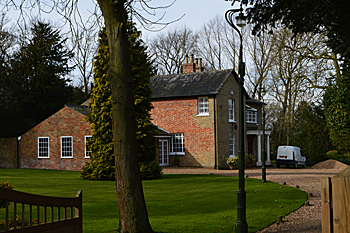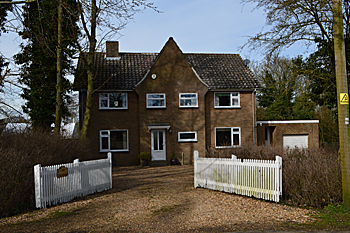Keysoe Vicarages

The Old Vicarage February 2016
The earliest mention of the vicarage building at Keysoe is in a terrier of property belonging to the Archdeaconry of Bedford dating from 1607 [ABE1]. The building is described as having four bays, of which three had a chamber over them. The house was half-timbered and had a tiled roof. On the ground floor were a hall, a parlour and a buttery. Of the three bays which had more than one storey, one bay had two storeys and two bays had three storeys. There were three bedchambers on both first and second floors making nine rooms in the house as a whole. Outside stood a small barn of two bays, which was half-timbered and thatched.
Another terrier made a reports on the building in 1712 [ABE II (I page 306)]. At this time it was partly thatched and partly tiled. It now had three rooms on the ground floor (one floored with clay, the other two with boards) and three ceiled chambers on the first floor, no mention being made of a second floor. A small barn and a stable stood outside.
Former County Archivist Patricia Bell transcribed episcopal visitations to the county for the first part of the 18th century as Bedfordshire Historical Record Society volume 81. The questionnaire sent out in connection with the visitation of 1712 was completed by the vicar who noted that he lived in his vicarage house. Questionnaires in 1717 and 1720 had the same answer. Of this old building only a small part [see below] seems to have survived.
![Keysoe Vicarage ground floor plan 1828 [X392/5] the kitchen is at the bottom left](/CommunityHistories/Keysoe/Keysoe-Images/Keysoe-Vicarage-ground-floor-plan-1828-X392-5.jpg)
Keysoe Vicarage ground floor plan 1828 [X392/5] the kitchen is at the bottom left
In 1814 the vicarage was reported as “not fit for the residence of a married man” [P48/0/1]. In 1828 plans were drawn up by surveyor and builder John Quick of Kimbolton [Huntingdonshire] for additions; these are partly held at Lincolnshire Archives Office [MGA147] and partly by Bedfordshire Archive and Record Service [X392/5]. A letter of April 1828 written by the Vicar, William B Winning, to the Governors of Queen Anne’s Bounty, which loaned money for improvements to parsonages secured against the buildings, reads [X392/5/2]: “I have to state that there is a small Tenement which goes by the name of the Vicarage House that hitherto no Vicar has lived in it, being always occupied by small Farmers, the Tenants of the Glebe Land. The late Incumbent by direction of the Arch Deacon pulled down all but the best Room (which is left for the Kitchen) and the chamber above and rebuilt 4 very small rooms 12 feet square as temporary lodgings for a Curate; but in consequence of death he left it in a very imperfect state. It is now proposed to make some slight alterations and to add two large Rooms with some conveniences to render it more fitting for the family residence of a clergyman of the Church of England. There are no materials of any kind”.
![Keysoe Vicarage elevation in 1828 [X392/5]](/CommunityHistories/Keysoe/Keysoe-Images/Keysoe-Vicarage-elevation-in-1828-X392-5.jpg)
Keysoe Vicarage elevation in 1828 [X392/5]
In 1841 and 1842, by which time Bedfordshire had moved from the Diocese of Lincoln to the Diocese of Ely, plans were drawn up for additions to the vicarage by Bedford builder James Horsford; there are in Cambridge University Library [EDR/G3/40 MGA/BED/4], specifications [P48/2/4/4] correspondence [P48/2/4/5] are with Bedfordshire Archive and Record Service
![Drawing of Keysoe Vicarage about 1842 [P48-2-4-7]](/CommunityHistories/Keysoe/Keysoe-Images/Drawing-of-Keysoe-Vicarage-about-1850-P48-2-4-7350x213.jpg)
Drawing of Keysoe Vicarage about 1842 [P48/2/4/7]
The Rating and Valuation Act 1925 specified that every building and piece of land in the country was to be assessed to determine its rateable value. However, no detailed survey of the Vicarage was made because: “New Incumbent not yet in” [DV1/C211/130]. Water was laid on to the Vicarage in 1936 [P48/2/4/9] and electricity in 1951 [P48/2/4/10].
In the latter part of the 20th century the church sold off most of its older parsonages, building smaller modern dwellings where appropriate for its clergy. This was the case with Keysoe. The new Vicarage stands nearby its predecessor

The Vicarage March 2016